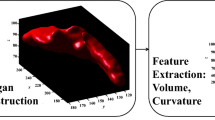Abstract
Interpreting complex paediatric body MRI studies requires the integration of information from multiple sequences. Image processing software, some freely available, allows the radiologist to use simple and rapid post-processing techniques that may aid diagnosis. We demonstrate the use of fusion and subtraction post-processing techniques with examples from four areas of application: enterography, oncological imaging, musculoskeletal imaging and MR fistulography.









Similar content being viewed by others
References
Rosset A, Spadola L, Ratib O (2004) Osirix: an open source software for navigating in multidimensional DICOM images. J Digit Imaging 17:205–216
Kawasumi Y, Yamada T, Ota H et al (2008) High-resolution monochrome liquid crystal display versus efficient household colour liquid crystal display: comparison of their diagnostic performance with unenhanced CT images in focal liver lesions. Eur Radiol 18:2148–2154
Townsend DW (2008) Combined PET/CT: the historical perspective. Semin Ultrasound CT MR 29:232–235
Gaertner FC, Fürst S, Schwaiger M (2013) PET/MR: a paradigm shift. Cancer Imaging 13:36–52
Spadola L, Rosset A, Seeger L et al (2005) ‘Color fusion MRI’: an effective technique for image visualization in a variety of clinical applications. Med Imaging. doi:10.1117/12.594643
Mir N, Sohaib SA, Collins D et al (2010) Fusion of high b-value diffusion-weighted and T2-weighted MR images improves identification of lymph nodes in the pelvis. J Med Imaging Radiat Oncol 54:358–364
Nechifor-Boilă IA, Bancu S, Buruian M et al (2013) Diffusion weighted imaging with background body signal suppression/T2 image fusion in magnetic resonance mammography for breast cancer diagnosis. Chirurgia (Bucur) 108:199–205
Tay KL, Yang JL, Phal PM et al (2011) Assessing signal intensity change on well-registered images: comparing subtraction, color-encoded subtraction, and parallel display formats. Radiology 260:400–407
Bhatia M, Rosset A, Platon A et al (2010) Technical innovation: multidimensional computerized software enabled subtraction computed tomographic angiography. J Comput Assist Tomogr 34:465–468
Sebag G, Ducou Le Pointe H, Klein I et al (1997) Dynamic gadolinium-enhanced subtraction MR imaging — a simple technique for the early diagnosis of Legg-Calvé-Perthes disease: preliminary results. Pediatr Radiol 27:216–220
Tsili AC, Argyropoulou MI, Astrakas LG et al (2013) Dynamic contrast-enhanced subtraction MRI for characterizing intratesticular mass lesions. AJR Am J Roentgenol 200:578–585
Ruehm SG, Nanz D, Baumann A et al (2001) 3D contrast-enhanced MR angiography of the run-off vessels: value of image subtraction. J Magn Reson Imaging 13:402–411
Watanabe Y, Dohke M, Okumura A et al (2000) Dynamic subtraction contrast-enhanced MR angiography: technique, clinical applications, and pitfalls. Radiographics 20:135–152
Boss A, Schaefer JF, Martirosian P et al (2006) Contrast-enhanced dynamic MR nephrography using the TurboFLASH navigator-gating technique in children. Eur Radiol 16:1509–1518
Cuffari C (2009) Diagnostic considerations in pediatric inflammatory bowel disease management. Gastroenterol Hepatol 5:775–783
Neubauer H, Pabst T, Dick A et al (2013) Small-bowel MRI in children and young adults with Crohn disease: retrospective head-to-head comparison of contrast-enhanced and diffusion-weighted MRI. Pediatr Radiol 43:103–114
Ziech ML, Lavini C, Caan MW et al (2012) Dynamic contrast-enhanced MRI in patients with luminal Crohn’s disease. Eur J Radiol 81:3019–3027
Humphries PD, Siegel M, Sebire N et al (2007) Tumors in pediatric patients at diffusion-weighted MR imaging: apparent diffusion coefficient and tumor cellularity. Radiology 245:848–854
Von Kalle T, Winkler P, Stuber T (2013) Contrast-enhanced MRI of normal temporomandibular joints in children — is there enhancement or not? Rheumatology 52:363–367
Acknowledgments
This work was presented at the annual meeting of the European Society of Paediatric Radiology in Budapest, Hungary, in 2013.
Conflicts of interest
None
Author information
Authors and Affiliations
Corresponding author
Rights and permissions
About this article
Cite this article
A Watson, T., Olsen, Ø.E. Fusion and subtraction post-processing in body MRI. Pediatr Radiol 45, 273–282 (2015). https://doi.org/10.1007/s00247-014-3129-3
Received:
Revised:
Accepted:
Published:
Issue Date:
DOI: https://doi.org/10.1007/s00247-014-3129-3




